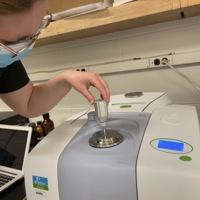Browse Exhibits (1 total)
Emma Cieslik | Hot Button Issue: Material Composition Analysis of Archaeological Ceramic Buttons

This research analyzed 10 buttons recovered from an archaeological site for composition. The buttons were excavated from an unmarked 19th century African American cemetery in Lowndes County, Mississippi. Each button was sampled, and infrared spectra were obtained for each sample using Fourier Transform infrared spectroscopy. The unprocessed spectra were deconvolved, and a fourth derivative of spectra were obtained to check the validity of the peaks. Replicate spectra of each button were also obtained.
Preliminary project results indicate that the majority of button samples may be composed of a mixture of different types of feldspars, a group of technological minerals, clay, and sillimanite. Reference spectra for each feldspar type is very similar and makes distinct feldspar identification difficult. The spectral data indicate that these buttons are composed of materials consistent with the Prosser button method production. Prosser buttons were commonly used for clothing from 1840 onward (Sprague 2002). According to the patent, Prosser buttons were composed of flint and clays. Unlike the higher-quality Prosser buttons that were often made from ground quartz, these buttons were likely made of ceramic wasters, including a combination of the aforementioned feldspars.
These results contribute to the field of feldspar identification, material composition identification of archaeological artifacts, and the production profile of buttons dating to the Civil War period. Understanding button production provides interesting insight into industrial methods and clothing history.
Faculty Mentors: Dr. Patricia Lang (Department of Chemistry) and Dr. Homes Hogue (Department of Anthropology)
Department of Chemistry and Department of Anthropology
Undergraduate
Honors College
